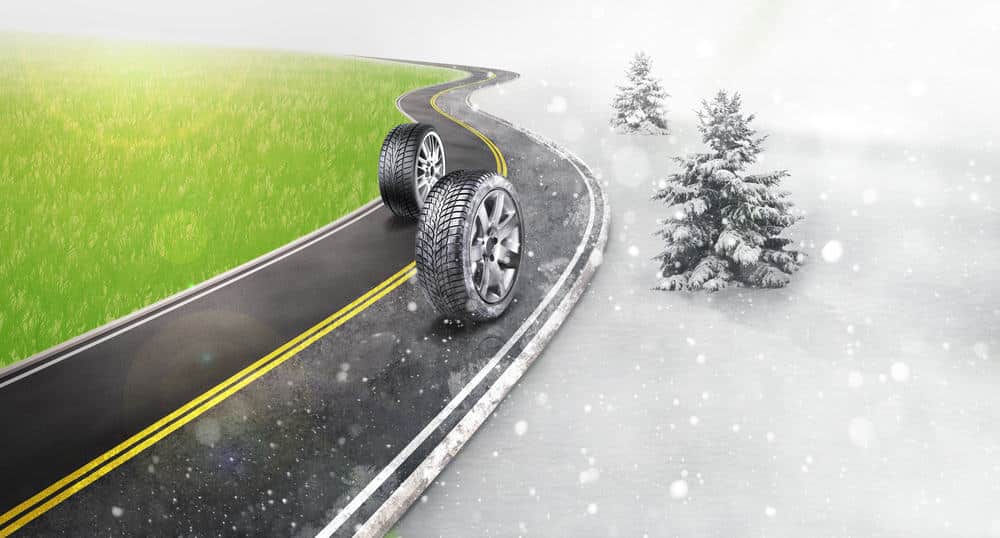
People use their cars less in winter than in the summer. However, over half of all motoring accidents occur during the cold months. Many of these are down to the fact that people overestimate the amount of distance it takes to brake in the cold weather. In many places where the temperatures plummet and there are extreme seasons, car drivers switch to special tyres for this period. What are the main differences between summer and winter tyres, and when should you put them on your vehicle?
Table of contents:
- Materials
- Grooves and Patterns
- Reduction in Braking Distance
- Durability
- When to Fit Winter Tyres and Summer Tyres
- A Third Option?
- And Finally… A Practical Notes
Materials
You’ll get no prizes for guessing that the differences between summer and winter tyres come from their construction. No doubt during the early days of motoring some bright spark noticed that the bouncy summer tyres they were using to save the bottoms of their affluent vehicular passengers slid about on icy roads. At first this caused some head scratching moments, as the early tyre pioneers wondered why their soft summer tyres didn’t grip the cold road. This was until someone observed that this was down to the fact that the tyres were freezing, making them hard and unable to cope with rugged and frozen surfaces. A few apologies and a couple of hat doffing moments later, another clever clogs invented tyres that were made from a temperature resistant rubber that keeps its flexibility in even sub zero conditions, which is far more effective at gripping the road’s surface. Jokes aside, this is achieved by putting larger amounts of silicon into the rubber mix, which makes it more pliable at colder temperatures.
Grooves and Patterns
No we’re not talking about making knitwear for a funky night out – we’re talking about the tread that feature on tyres, providing them with better grip on the road. Believe it or not winter tyres actually work by collecting snow in their grooves which provides a better grip on icy roads than a plain rubber tread. As a result winter tyres tend to have a larger amount of grooves on their surface than a standard summer tyre, and these grooves also tend to be deeper and wider.
Reduction in Braking Distance
So now we’ve filled you in on how summer and winter tyres are constructed, what differences can you expect to feel behind the wheel of your petrol slurping SUV as you navigate your favourite roads at top speeds? Well, you certainly won’t want to be pushing the pedal to the metal in the colder months if you’re driving with summer tyres on your car as this will increase your braking distances dramatically. On snow, driving at 30mph it will take 43 metres to brake with summer tyres as opposed to 35 metres with winter tyres. On ice you’ll slip and slide for nearly 70m when braking at just 20mph with summer tyres, with winter tyres knocking 10m off that distance.
Durability
We already know what your next questions going to be – “if winter tyres are so great, then why not fit them to your car all year round?” Well there’s a simple reason why you need to change back to summer tyres during the warmer months – durability. Winter tyres, which are made from a softer rubber compound, will wear out much faster than summer tyres, costing you money to replace them. The grip will also wear out on winter tyres, affecting your fuel efficiency and driving up your fuel consumption costs. With the price of petrol sky rocketing year in year out, this won’t be a good thing for your car or your bank balance.
When to fit Winter Tyres and Summer Tyres
No doubt we’re going to raise a few eyebrows if we make the obvious point that winter tyres need to go on your car during the colder months of the year. So if you’re living in Tasmania, an island location off Australia, then you’ll want to put your winter tyres on during June and July. Those of us who are living in the good old Northern hemisphere, where the winters are colder and the roads considerably more congested, will want to change their summer tyres over to winter tyres in late October or at least by mid November and then back again in early April.
A Third Option?
Believe it or not a number of tyre manufacturers have noticed the need for cars to change between tyre types over the seasons and have turned this into a business opportunity by creating an all season tyre. As you’d expect these tyres are neither as durable as summer tires in the hot months, nor are they as good at gripping the road surface as winter tyres during the cold months – the only advantage that they offer drivers is that they only have to buy one set of tyres to last all year round.
And Finally… A Practical Note
Winter can be a treacherous time in the UK, where we periodically have bad winters that are beset by lots of snow, ice and thick slush. Even though many roads are salted and gritted there can still be problematic patches of black ice and issues with lesser used roads. If you are thinking of buying winter tyres to use with your car then we would recommend that you also buy a set of wheels too, allowing you to change them quickly and easily when the cold months set in.







.png)
Pingback: Preparing your Car for Winter - BreakerLink Blog